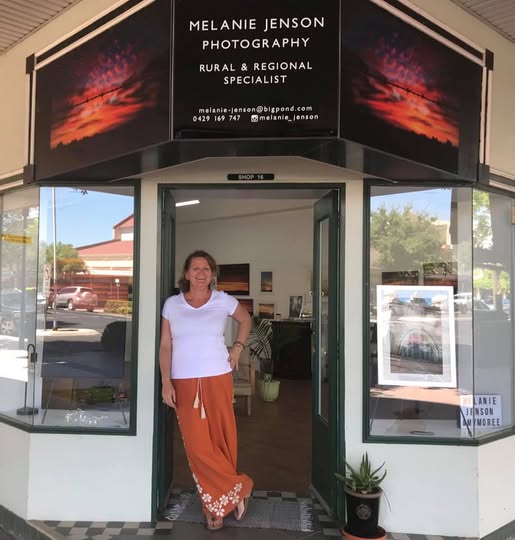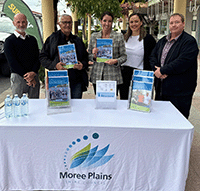Moree Plains Shire Heritage
Beginnings
The first inhabitants of Moree Plains Shire were the people of the Kamilaroi/Gamilaroi nation which extended from the Hunter Valley through to the Warrumbungle Mountains in the west and up through the present-day centres of Quirindi, Tamworth, Narrabri, Walgett, Moree and Mungindi in New South Wales to Nindigully in southwest Queensland.
An escaped convict, George ‘The Barber’ Clarke, is reported to have been the first European ‘settler’ of the area. He lived with several tribes of Aboriginal people, including the Kamilaroi, from 1826 until he was recaptured in 1831. Back in captivity, Clarke told of a vast inland river called the Kindur. His descriptions aroused the curiosity of the then acting governor of New South Wales, Colonel Patrick Lindesay, who was prompted to send Major Thomas Mitchell on an expedition into the region to investigate the claims. Mitchell gave a favourable report on the pastoral prospects of the area and squatters soon followed in Mitchell’s wake establishing pastoral runs, one of which was a station called ‘Moree’.
The movement of drovers and the coming of settlers soon attracted others to provide them with goods and services. Moree grew from a station to a village in 1852 and to a town in 1862. James and Mary Brand were the first to build in the settlement, constructing a general store in 1852 and adding a post office the following year. Moree continued to grow and the settlement’s first inn was opened in 1861. A Court of Petty Sessions was established in 1863 and a police station added in 1865. The first church (Wesleyan) was built in 1867, banking was established in 1876 and the first local newspaper was published in 1881, by which time the population of Moree had grown to 295.
The railway arrived in 1897. As closer settlement proceeded in the region, other villages also evolved. Mungindi, for instance, grew at the site of one of the main crossing points across the Barwon River. Taking advantage of the fact that the crossing point was also a popular camping site for drovers, Alexander Grant Walker began construction of the present day Mungindi by building a hotel, or inn, in 1863.
Aboriginal Heritage
The first inhabitants of Moree Plains Shire were the Kamilaroi, also known as the Gamilaroi or Gamilaraay.
The Kamilaroi were hunters and gatherers who lived off the bounty of the plains and waterways. They hunted animals such as kangaroos, emus, possums and echidnas; and gathered frogs, insect larvae and the eggs of several different animals. These foods were important sources of protein for the Kamilaroi, as were the fish, crayfish and mussels they caught in the rivers and streams. Yams and other roots were important vegetable foods. Men generally hunted, cleaned and prepared game for cooking, while women fished, gathered, and cooked.
Although the need for fresh water meant that the Kamilaroi followed a basically nomadic lifestyle, their practices indicate a more sophisticated level of development. They operated under a complex kinship and marriage system; they carried out mosaic burning to encourage fresh herbage for animals; they stacked grass seed for future winnowing and harvesting; they ground grain to be made into bread; and their rope making and weaving skills were very advanced. They had digging sticks, at least five types of spear, several varieties of boomerang for hunting and warfare, and a variety of stone axes. They also traded extensively with their neighbours.
Pioneering Heritage
By 1832 the black soil plains in the Moree district and the approaches to them had been explored by Europeans and sufficient was known for settlers to risk a new area of unsettled land. The first wave of European settlers were squatters who selected the most fertile land close to streams and rivers on which to establish grazing runs for flocks of sheep and herds of cattle. Although they had no legal rights to the land they occupied, they were able to make use of the land because they were the first – and often the only – Europeans in the area. The squatters’ use of the land did not go wholly uncontested, however. The Aboriginal people did not give up their land without a fight. In the years between 1836 and 1855, there were often violent clashes between the original inhabitants of the land and the European pioneers. Twelve spearing deaths of Europeans were recorded in the first eleven years of European settlement. The Aboriginal people also wounded a number of white settlers and caused considerable damage to their stock and buildings. The Aboriginal death toll during this period was not officially recorded but the Europeans’ weapons were much more deadly and it is certain that many Aboriginal people were killed.
Despite their differences, the Kamilaroi people and settlers gradually began to negotiate with each other and by 1855 Aboriginal men were being employed on properties as stock workers, shearers and shepherds while Aboriginal women were employed as domestic servants. This was of great benefit to the settlers, given that work was plentiful and labour was usually in short supply.
In 1861 the land in the Moree district was thrown open for free selection and the second wave of European settlers, the free selectors, moved into the area. The land which had previously been used by squatters was now to be divided and sold to selectors who wanted to buy a block of land. Since the squatters had put considerable effort into clearing and working the land, many were not keen to give up land to the newcomers. Those who could afford it, bought as much of the land they had claimed as possible.
Life for the settlers, both squatters and free selectors, was hard. Not only did they have to endure droughts, fires and floods, they had to start developing their land from scratch using nothing but hand tools. Land had to be cleared of native forest and scrub. Timber had to be cut and hauled to homestead sites and shaped into rafters and slabs. Bark for roofs had to be obtained or shingles had to be split from chunks of wood, or billets, that had also been split by hand. In addition, all the buildings and yards essential for farming and the keeping of stock had to be constructed before the land could start to become productive.
Settlers’ wives did not have an easy time of it either. As well as bearing and raising children, the wives were responsible for carrying out all the household duties by hand: cooking, washing, cleaning and making the family’s clothes. In addition, they usually took charge of keeping the poultry and running the dairy. Even selling produce was difficult because the settlers’ markets depended upon the durability of their goods. Wool was a safe commodity because it could be transported relatively easily by dray. Stock could be driven to distant markets. Dairy farmers, however, had to rely on local demand for milk, butter and cheese, although large consignments of cheese, which kept fairly well, could be marketed further away.





